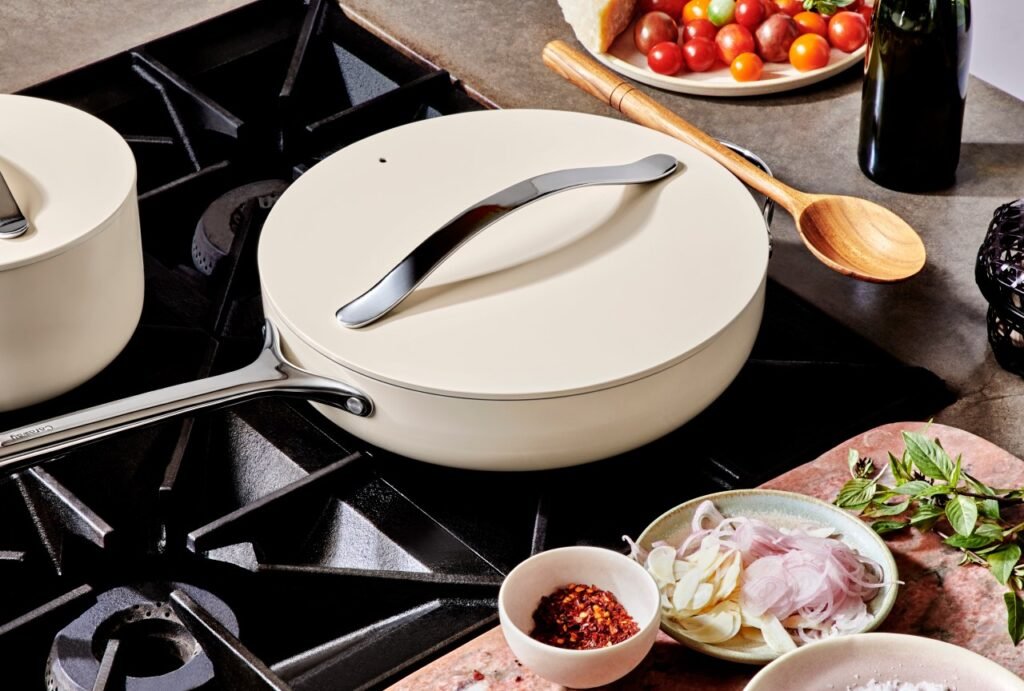
With widespread attention and glowing initial marketing, Caraway raised expectations for colorful, eco-friendly ceramic cookware. But two years in, the shine has dulled—revealing durability concerns, care restrictions, and mixed value. Here’s what you need to know.
Build & Design You’ll Notice Daily
Caraway features a mineral-based ceramic coating free from PTFE, PFAS, and PFOA, over a lightweight aluminum core with magnetic induction-ready bases (The Skillful Cook). The set includes a magnetic rack and lid organizer for neat storage. Caraway markets itself as safe, stylish, and space-savvy—premium in form and promise .
What Still Works
Efficient non-stick capability: In early months, eggs, crepes, pancakes glide easily with minimal oil—as reliable as top ceramic brands .
Even daytime cooking: Many testers praise consistent heating on gas or electric stovetops, with oven-safe durability up to 550 °F .
Aesthetic appeal: The sleek matte finish remains a frequent highlight—though external staining is common with use .
My own set still cooks without major sticking glitches at the two-year mark—and works especially well for steamed veggies, slow-cooked sauces, and reheated soups with nearly effortless cleanup.
Key Drawbacks Over Time
Nonstick wears quickly, especially on frying pans. Many users note performance degradation after just 6–12 months of moderate use . One reviewer observed:
“My frying pan lasted 4 months before I tossed it. … They lose their non‑stick properties very quickly” .
Surface scratches easily, even with silicone utensils. Once scratched, the ceramic can degrade or flake. As one Reddit user put it:
“Used low heat… still scratched. It stops being non-stick pretty quickly”.
Handles get hot fast under low‑to‑medium stovetop use or oven time.
Uneven heat spots—Tests by Prudent Reviews revealed temperature variance up to 50–100°F across the pan surface. This makes browning or searing inconsistent without constant repositioning .
High maintenance required: The cookware must be hand-washed, stored carefully, never overheated, and used only with soft tools .
One user shared:
“Nonstick cookware stinks. … If you really want non‑stick, GreenPan isn’t bad” .
Price vs. Reality
At $395–495 for a four-piece set, Caraway sits in premium territory (kitchenBap). Other ceramic or Teflon sets cost significantly less—yet Caraway doesn’t deliver longer lifespan. A Reddit consensus:
“Disposable pans shouldn’t cost $100 each… lifetime pieces cost a bit more”.
Despite white-label eco claims, their one-year warranty suggests modest confidence in longevity .
Summary: What I’ve Learned Over Two Years
Best for low-fat, low-heat cooking: Stir-fries, soups, eggs, and reheated meals.
Expect surface wear within one year unless you’re ultra-careful.
Great if aesthetics matter—but plan for visible staining and handling care.
Not ideal for searing, high-heat cooking, or long-term budget-focused use.
Final Verdict
Caraway cookware looks great and performs well initially—but its ceramic coating isn’t built to last like stainless steel, cast iron, or fully clad metal sets. After 2+ years, you’ll likely encounter scratches, staining, and non-stick fade unless strict care routines are followed.
If your priority is clean design and non-toxic simplicity, and you’re okay treating cookware delicately, Caraway is reasonable. But if you cook frequently, sear often, or want cookware to last beyond a couple of years, stainless steel or cast iron may offer better long‑term value.
